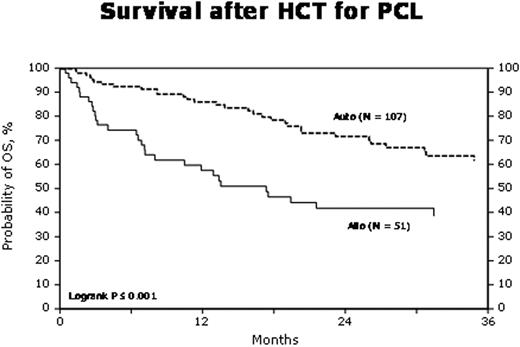Abstract
Abstract 532
Primary Plasma cell leukemia (PCL) is a rare plasma cell disorder characterized by an aggressive clinical course. The efficacy of autologous and allogeneic HCT in PCL is uncertain due to the small number of patients that have been reported in the literature. To determine the potential for long-term disease control using HCT in PCL, we performed a retrospective review of 160 patients with primary PCL who received autologous (n=107), allogeneic (n=52) or syngeneic (n=1) HCT and were reported to the CIBMTR between 1995 and 2006. Kaplan–Meier analysis was used for overall survival (OS) and progression free survival (PFS). Cumulative incidence estimates of non-relapse mortality (NRM), relapse, acute and chronic GVHD were calculated.
Median age at the time of autologous HCT was 57 years (range, 32-74 years) and allogeneic HCT was 48 years (range, 24-62 years). Median time from initial treatment to autologous HCT was 7 months and allogeneic HCT was 6 months. At the time of transplant, in the autologous HCT group, 19% patients were in complete remission, 56% in partial remission and 1% had relapsed/progressive disease; in the allogeneic HCT group, 17% were in complete remission, 46% in partial remission and 10% had relapsed/progressive disease. In the allogeneic HCT group, 83% of the patients received myeloablative conditioning regimens and 17% received nonmyeloablative/reduced-intensity conditioning. The rate of acute GVHD was 35% (95% confidence interval [CI], 22%-49%) and the rate of chronic GVHD at 3 years was 27% (95% CI, 13%-40%). After a median follow-up of 38 months, 20 of the 52 patients (38%) are alive in the allogeneic HCT group and 68 of the 107 pts (64%) are alive in the autologous HCT group (Figure 1). Progressive disease accounted for 38% of the deaths in the allogeneic HCT group and 86% of the deaths in the autologous HCT group. The outcomes are summarized in table 1. The remarkable overall survival of patients after autologous HCT in this analysis is noteworthy and indicates that autologous HCT is a safe and acceptable treatment option for patients with primary PCL. Although relapse rates are lower, allogeneic HCT carries a much higher risk of NRM and should be considered primarily in the context of a clinical trial.
| Outcomes . | Allogeneic Probability (95% CI) . | Autologous Probability (95% CI) . |
|---|---|---|
| TRM @ 1 year | 26 (15 - 39) | 2 (0 - 5) |
| TRM @ 3 years | 40 (27 - 55) | 5 (1 - 10) |
| Relapse @ 3 years | 40 (26 - 54) | 61 (49 - 72) |
| PFS @ 3 years | 20 (10 - 33) | 34 (24 - 46) |
| OS @ 3 years | 39 (25 - 53) | 62 (51 - 73) |
| Outcomes . | Allogeneic Probability (95% CI) . | Autologous Probability (95% CI) . |
|---|---|---|
| TRM @ 1 year | 26 (15 - 39) | 2 (0 - 5) |
| TRM @ 3 years | 40 (27 - 55) | 5 (1 - 10) |
| Relapse @ 3 years | 40 (26 - 54) | 61 (49 - 72) |
| PFS @ 3 years | 20 (10 - 33) | 34 (24 - 46) |
| OS @ 3 years | 39 (25 - 53) | 62 (51 - 73) |
Lonial:Celgene: Consultancy; Millennium: Consultancy, Research Funding; BMS: Consultancy; Novartis: Consultancy; Gloucester: Research Funding.
Author notes
Asterisk with author names denotes non-ASH members.


This feature is available to Subscribers Only
Sign In or Create an Account Close Modal